This Post May Contain Affiliate Links. Please Read Our Disclosure Policy.
This vibrant, tangy chimichurri sauce is not only the easiest chimichurri recipe to make, it’s also the best I’ve ever tasted! A perfect copycat for Texas de Brazil’s own chimichurri, it’s full of fresh herbs, rich oil, bold garlic, and perfectly balanced spices. I have a jar of this chimichurri in my fridge at all times to use as a marinade or sauce for steaks, chicken, shrimp, fish, or pork.
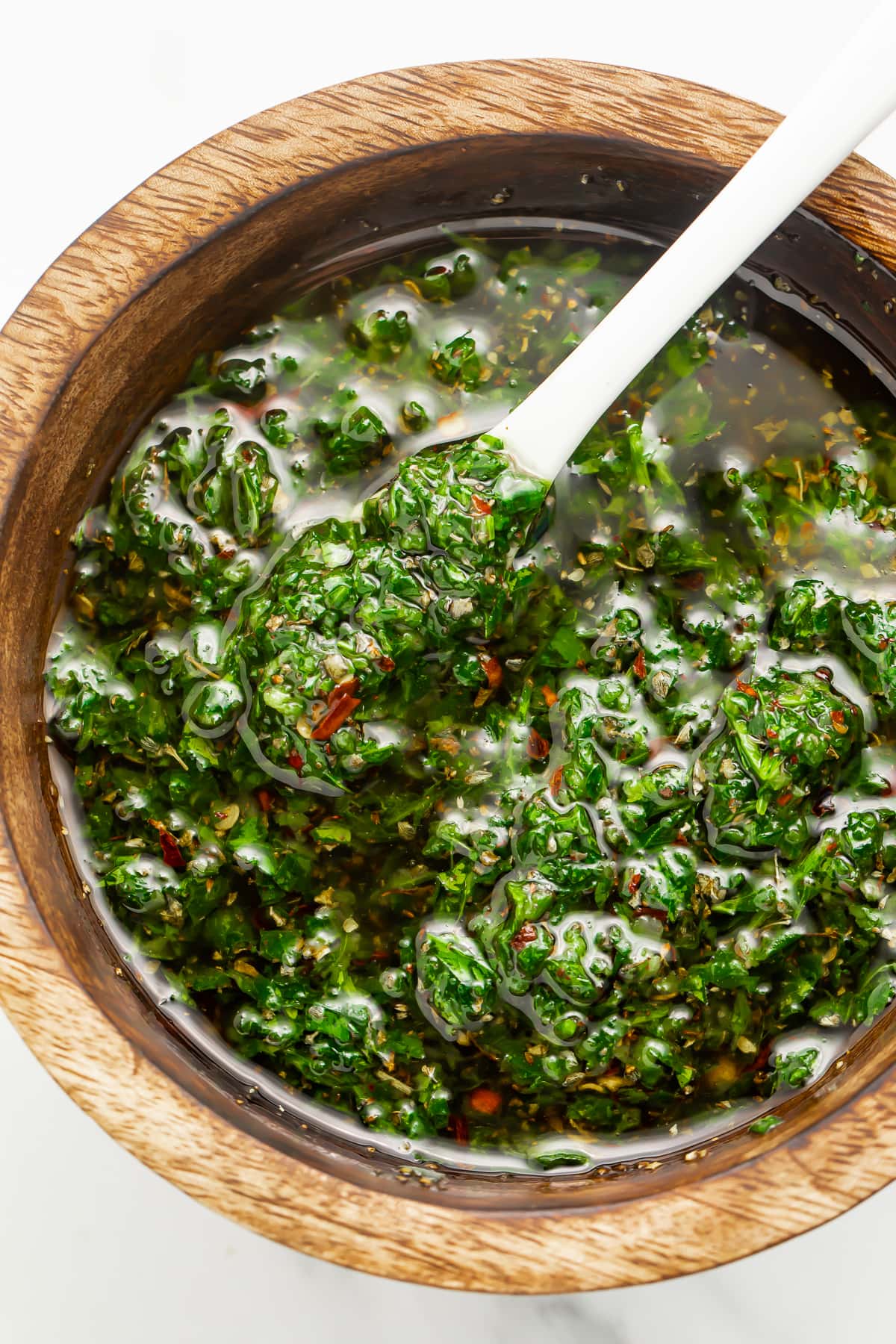
🌿 What is Chimichurri?
Chimichurri is a savory, herbaceous sauce that originated in Argentina and Uruguay, though today its popularity extends far beyond Latin America. There’s no cooking involved in making chimichurri, as it’s commonly used as a marinade or a condiment for various meats or sides.
The ingredients list for classic green chimichurri is simple: garlic, olive oil, parsley, vinegar, oregano, red pepper flakes, and salt.
Because this version is a copycat of Texas de Brazil’s chimichurri, the recipe differs a little from traditional chimichurri due to the addition of cilantro. You’re welcome to replace the cilantro with additional parsley for a more authentic sauce! It also uses lemon juice for acidity instead of red wine vinegar. I personally prefer the flavor of the lemon juice with the rest of the ingredients, but you can swap it out easily.
🧄 What Makes This Recipe So Good
- When I tell you I’m obsessed with this sauce, I mean I am OB. SESSED. WITH. THIS. SAUCE! I’ve been making it for a solid decade now, and it’s such a staple in my meal plan that to this day it has its own spot in my fridge. I always have a batch on hand. The flavors are incredible, and it’s so unbelievably versatile. I’ve used it on basically everything at this point – seared ribeye, chimichurri rice, garlic mashed potatoes, fried eggs, even a dip for pizza! I’ve never once been disappointed.
- This chimichurri recipe is a perfect copycat for the chimichurri served at Texas de Brazil, and making it could NOT be easier. Basically all you have to do is add everything to the food processor and process until you’ve got a well-mixed sauce. I like to add the ingredients incrementally to be sure everything’s finely chopped and you don’t get any giant pieces of garlic or herb leaves in a bite.
- Since this chimichurri recipe really only uses oil, herbs, and spices, it’s naturally paleo, Whole30, keto, low carb, vegetarian, vegan, dairy free, and gluten free. I know it’s hard to believe something this good works for so many different dietary needs, but… believe it! It’s true!
👩🏼🍳 Chef’s Tips
- One of the really great things about this chimichurri recipe is that it’s totally customizable. You can adjust the amounts of each ingredient until you’ve got your perfect sauce. Maybe you want less oil and more herbs. Go for it! Scale back the garlic if you’re not big on that raw flavor. Replace the cilantro with more parsley for a more authentic chimichurri. Use red wine vinegar instead of lemon juice. Anything goes!
- When it comes to salt, I always recommend starting out low. I like my chimichurri salty, so I actually use a full tablespoon in my own batches. I’ve written the recipe with just ½ tablespoon, though, because you can always add more, but you can’t take it back out. It’s way better (and less frustrating) to under-salt it than to over-salt it.
- If you don’t have a food processor, you can actually make this whole chimichurri recipe by hand instead! It takes a little more effort and a little more time, but you still end up with a delicious chimichurri in the end. Use a sharp knife to mince the garlic, parsley, and cilantro really well. From there, add everything to a bowl and whisk vigorously until all the ingredients are fully incorporated.
- It’s super important that you use a high-quality, great-tasting olive oil (or EVOO) to make your chimichurri. Since the olive oil is so prominent, using a subpar oil can absolutely wreck the flavor of the sauce. Low-quality olive oils will taste oily and bitter, and some are even diluted with older batches of olive oil or other oils altogether. High-quality oils have a more subtle, herby, sometimes fruity taste and aroma. Your oil needs to be fresh, too. Even high-quality olive oil will taste rancid after it expires.
💡 Chimichurri Variations
- Light Chimichurri: Instead of 1 cup olive oil, use ⅓ cup water and ⅔ cup olive oil. For an even lighter chimichurri, use ½ cup water and ½ cup olive oil.
- Avocado Chimichurri: Instead of 1 cup olive oil, use only ½ cup olive oil and add the flesh of one large avocado.
- Mild Chimichurri: Reduce the amount of crushed red pepper flakes or omit them entirely.
💬 Frequently Asked Questions
No! They’re both herb sauces that use garlic and olive oil, but that’s pretty much where the ingredient similarities end. Pesto is typically made with basil, pine nuts, parmesan, and pecorino. You won’t find any of those ingredients in a chimichurri.
If your parsley was picked too late in the season, it can have a bitter flavor, which would affect the taste of the chimichurri. Older olive oil and low-quality olive oil can also make the sauce bitter, as can using too much garlic.
Nope! At least, I don’t consider it spicy. This recipe does include red pepper flakes, so if you’re heat-sensitive, you may want to reduce or eliminate that ingredient.
Traditionally, chimichurri is a mixture of garlic, olive oil, parsley, red wine vinegar, oregano, crushed red pepper, and salt.
Sometimes! Authentic recipes generally only use parsley – no cilantro at all. This recipe is a copycat for Texas de Brazil’s chimichurri which does use cilantro.
Pretty much anything! It’s perfect as a marinade or topping for grilled or roasted meats like steak, chicken, shrimp, scallops, pork chops, fish, etc. You can also drizzle chimichurri over roasted vegetables, baked or mashed potatoes, fried eggs, cooked rice, salads, and pasta.
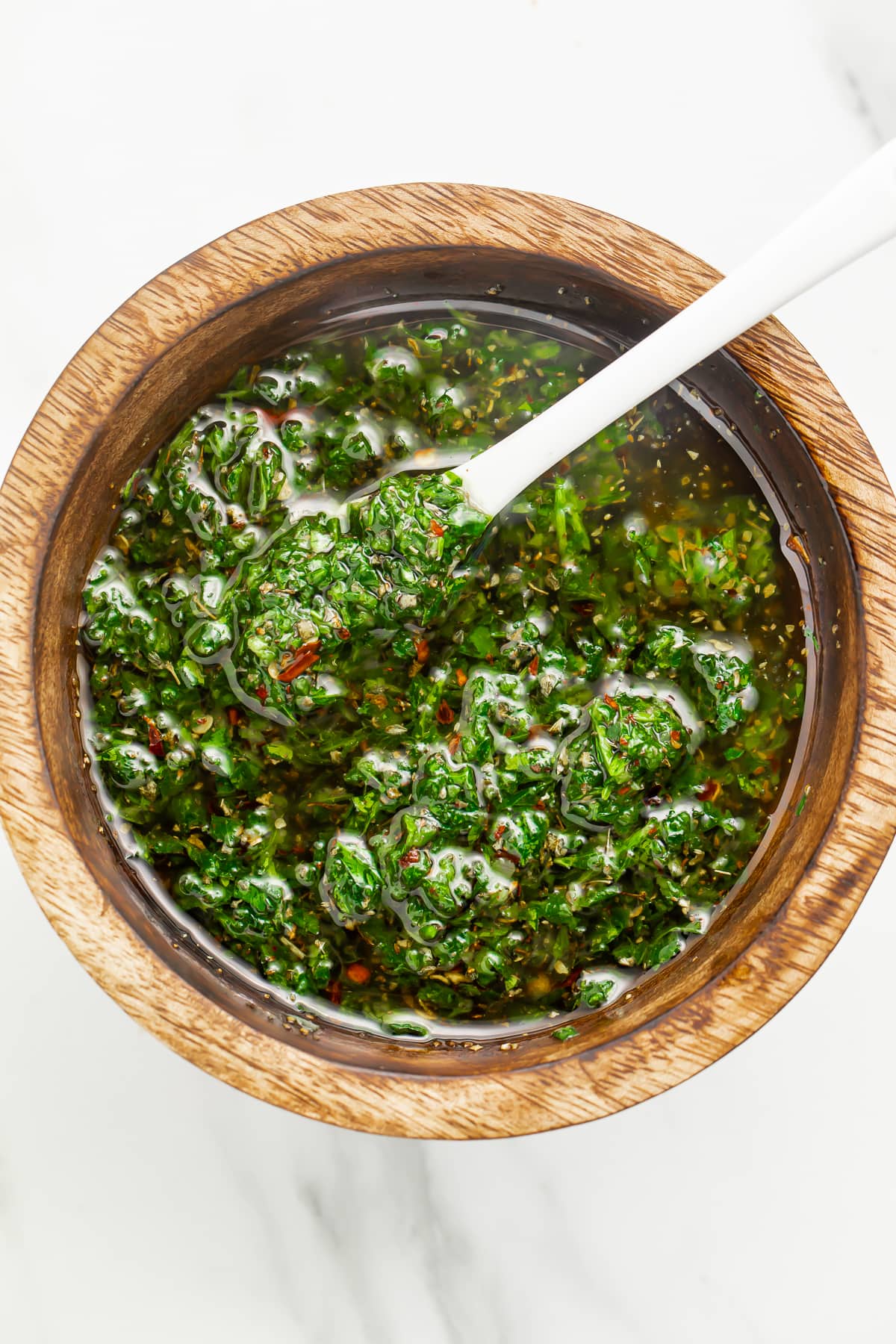
🥘 Try These Recipes While You’re Here!
- Cream Cheese Garlic Skillet Chicken
- Keto Eggplant Parmesan
- Garlic Bread Casserole
- Chicken Stroganoff
- How to Cook Nopales (Cactus Paddles)
- Sous Vide Pork Belly
- Carnitas Burritos
- Sauteed Shrimp in Garlic Butter Sauce
- Grilled Mango with Chili-Lime Salt
- Chickarina Soup
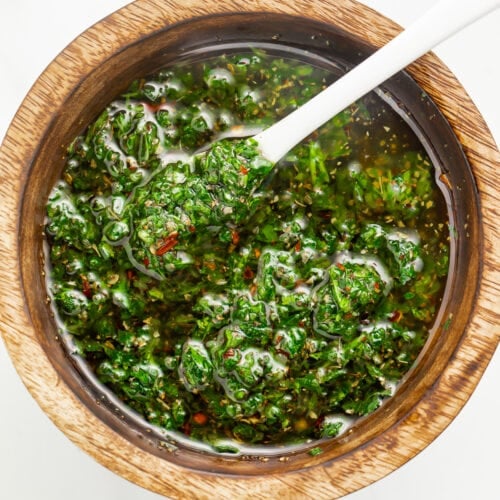
Best Ever Chimichurri Recipe (from Texas de Brazil)
Equipment
- Food processor see Notes
- Silicone spatula
- Airtight container
Ingredients
- 2 tablespoons roughly chopped fresh garlic approximately 6 cloves, more or less to taste
- ½ cup fresh parsley leaves
- ¼ cup fresh cilantro leaves
- 1 cup high-quality olive oil or avocado oil
- ¼ cup fresh lemon juice 4 tablespoons, from approximately 2 large lemons
- 1 tablespoon dried oregano
- 1 tablespoon crushed red pepper more or less to taste
- ½ tablespoon table salt plus more to taste
Instructions
- Add 2 tablespoons roughly chopped fresh garlic to bowl of food processor. Pulse garlic until minced.
- Add ½ cup fresh parsley leaves and ¼ cup fresh cilantro leaves to food processor with minced garlic. Pulse until leaves are uniformly chopped. Scrape down sides of food processor bowl with silicone spatula as needed.
- Add 1 cup high-quality olive oil, ¼ cup fresh lemon juice, 1 tablespoon dried oregano, 1 tablespoon crushed red pepper (to taste), and ½ tablespoon table salt (to taste) to food processor. Pulse until ingredients are well combined, being careful not to over-process mixture into paste. Scrape down sides of food processor bowl with silicone spatula as needed.
- Taste chimichurri and add garlic, crushed red pepper, and salt as needed. Add ingredients in small increments and pulse 1 to 2 times to incorporate. Taste again and continue adjusting if needed.
- When satisfied with flavor, use prepared chimichurri to marinate meat of choice, or transfer sauce to airtight container and refrigerate until ready to use.
Video
- Food Processor: If you don’t have a food processor, mince the garlic, parsley, and cilantro with a sharp knife, then add all ingredients to a mixing bowl. Whisk vigorously until the ingredients are well incorporated.
- Oil: Use a high-quality olive oil or EVOO, and make sure it’s fresh. Low quality oils will taste bitter and oily, and older oils will taste rancid. You can also replace the olive oil with avocado oil, but that will give the sauce a slightly different flavor.
- Cilantro: This is a copycat recipe for Texas de Brazil’s chimichurri sauce, which uses cilantro as the primary herb. Traditional Argentinian chimichurri typically uses parsley only. Feel free to replace the ¼ cup of cilantro leaves with an additional ¼ cup of parsley leaves if you’d prefer.
- Crushed Red Pepper: If you’re heat-sensitive, start with only ¼ or ½ tablespoon of red pepper flakes. I don’t consider this recipe very spicy as-written, but you might!
- Salt: I generally use 1 tablespoon of salt in my chimichurri, but I recommend starting with only ½ tablespoon, then adding more if needed.
- Consistency: This is intended to be a thin, liquidy, oily sauce. Check out the video below to get an idea of the target consistency. Be careful not to over-mix the ingredients or you’ll end up with more of a paste.
- Storage: Keep the chimichurri sauce refrigerated in an airtight container. It’ll keep approximately 2 weeks if stored properly. If any separation occurs, shake container or whisk sauce vigorously until ingredients are reincorporated.
Approximate Information for One Serving
Nutrition Disclaimers
Number of total servings shown is approximate. Actual number of servings will depend on your preferred portion sizes.
Nutritional values shown are general guidelines and reflect information for 1 serving using the ingredients listed, not including any optional ingredients. Actual macros may vary slightly depending on specific brands and types of ingredients used.
To determine the weight of one serving, prepare the recipe as instructed. Weigh the finished recipe, then divide the weight of the finished recipe (not including the weight of the container the food is in) by the desired number of servings. Result will be the weight of one serving.
Did You Make This Recipe?
Tag @40aprons on Instagram and be sure to leave a review on the blog post!
Never Miss A Meal!
New Recipes Straight To Your Inbox
A curated selection of our most recent recipes, delivered straight to your inbox once a week.
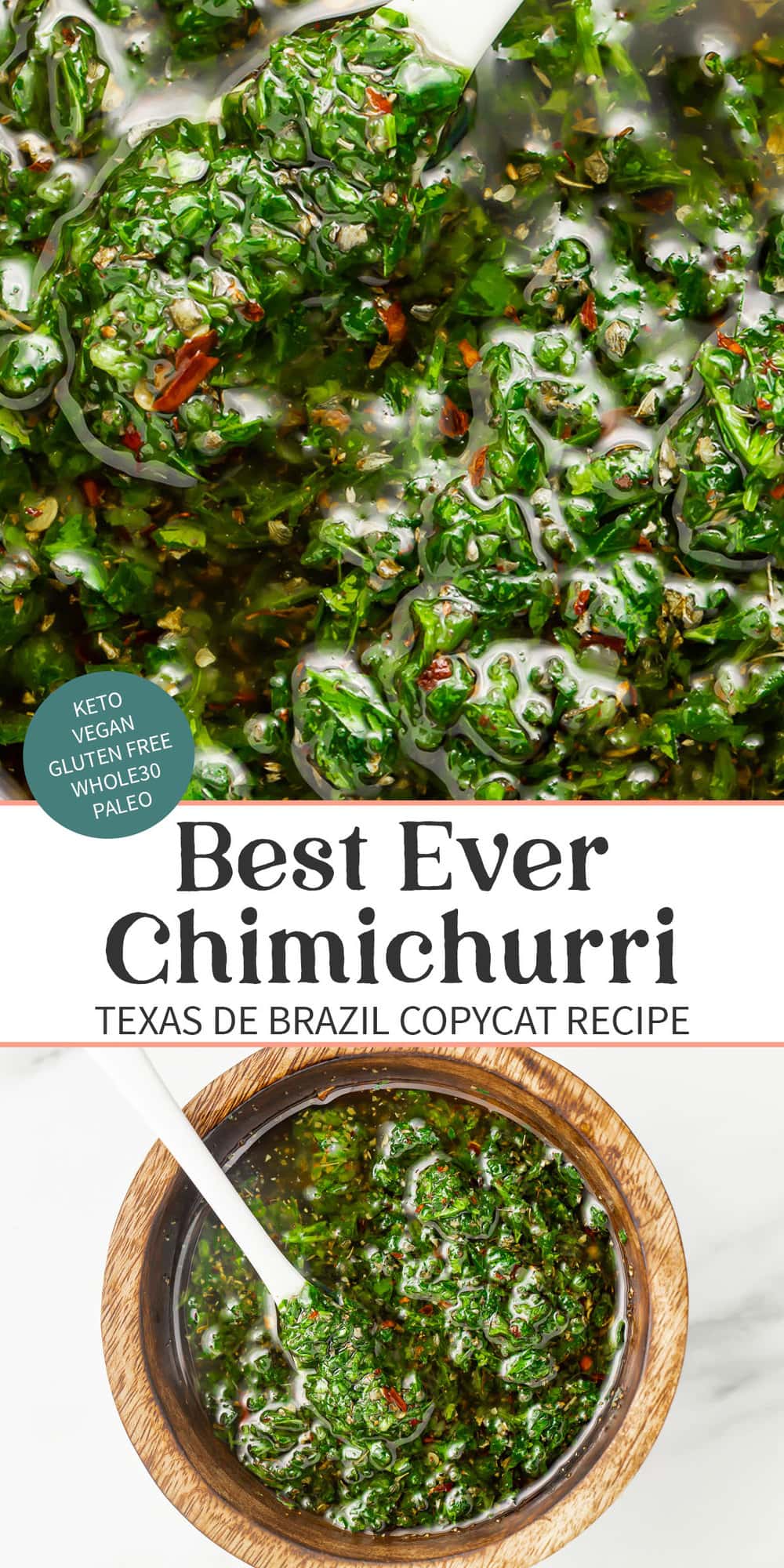
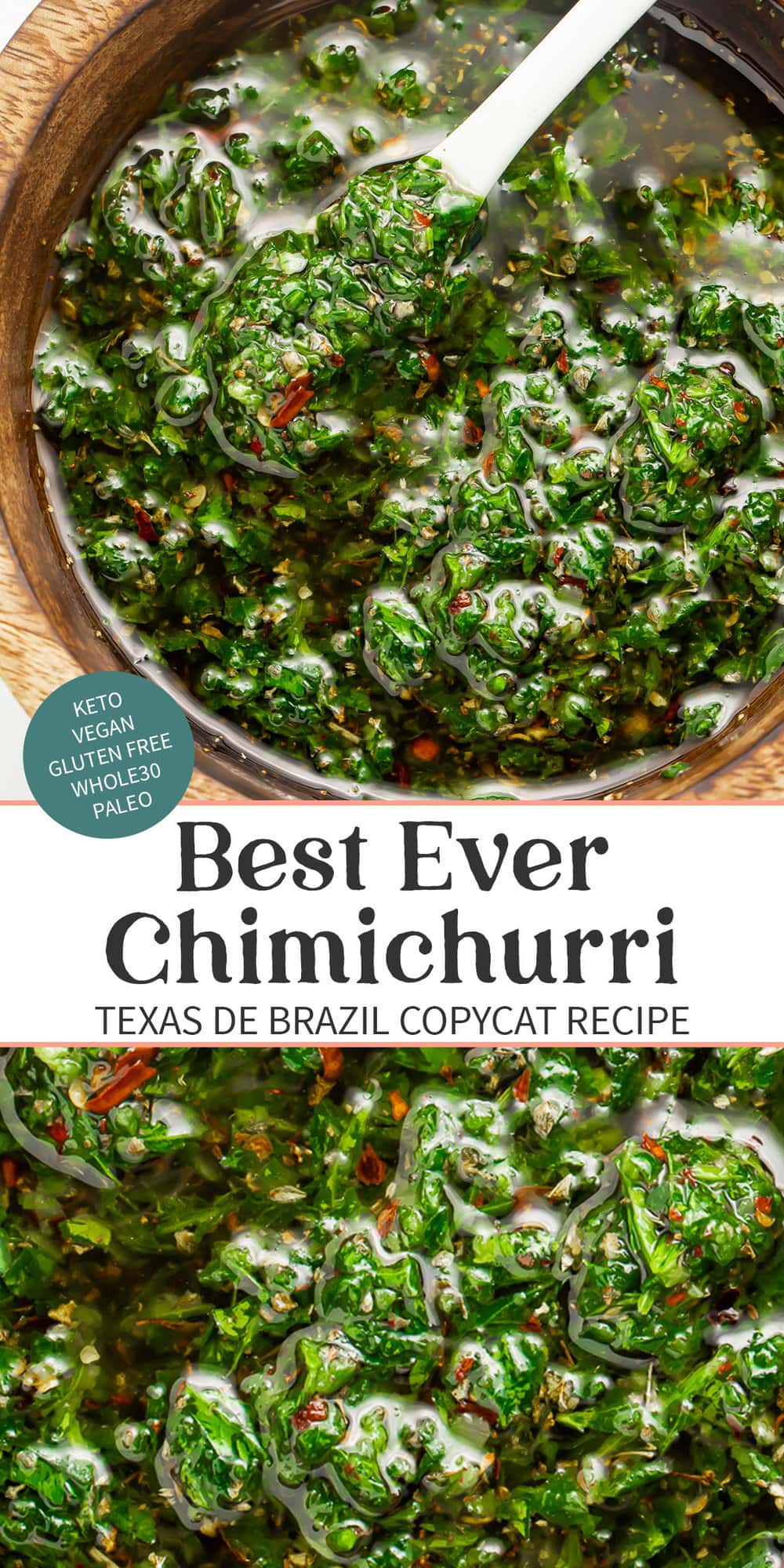
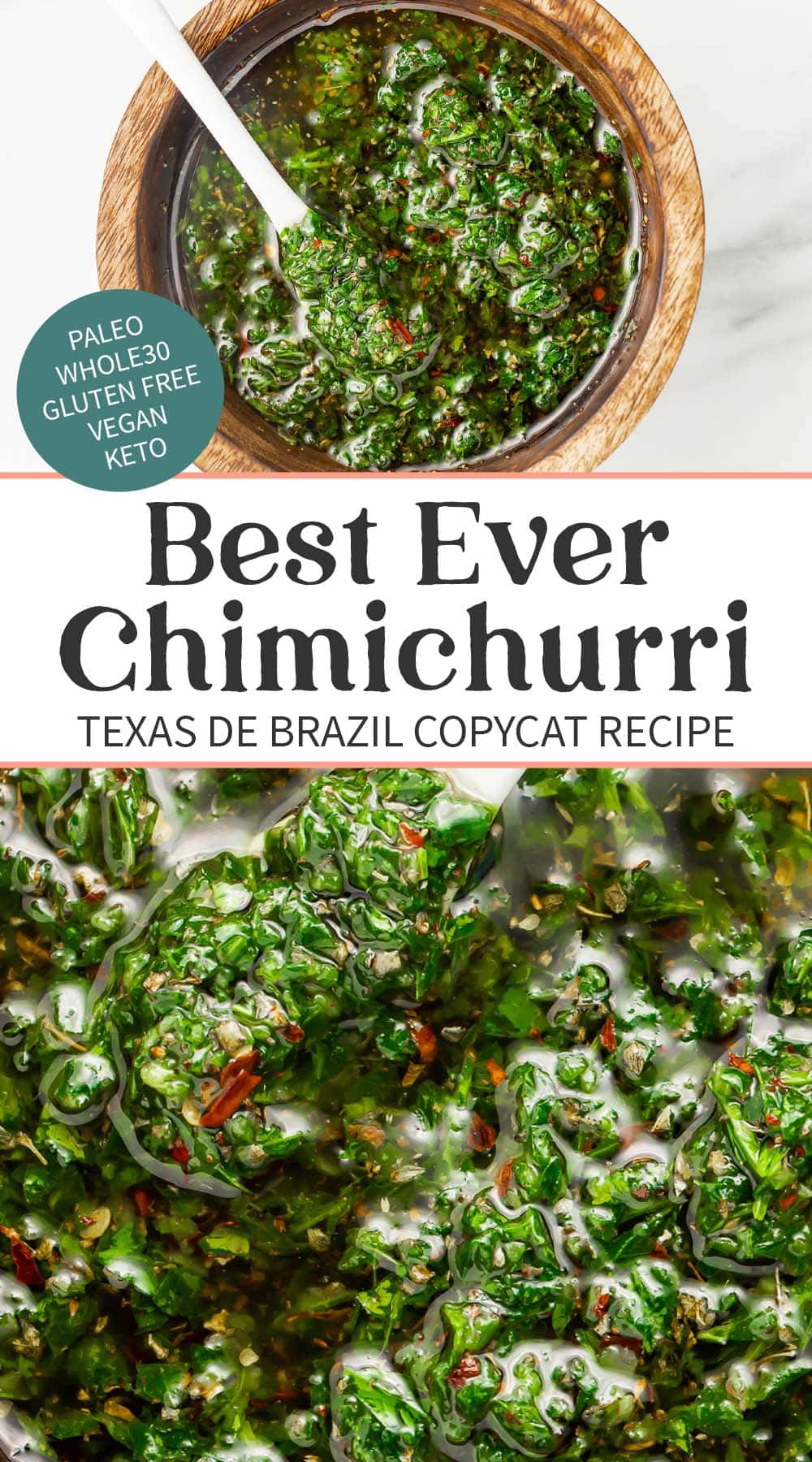
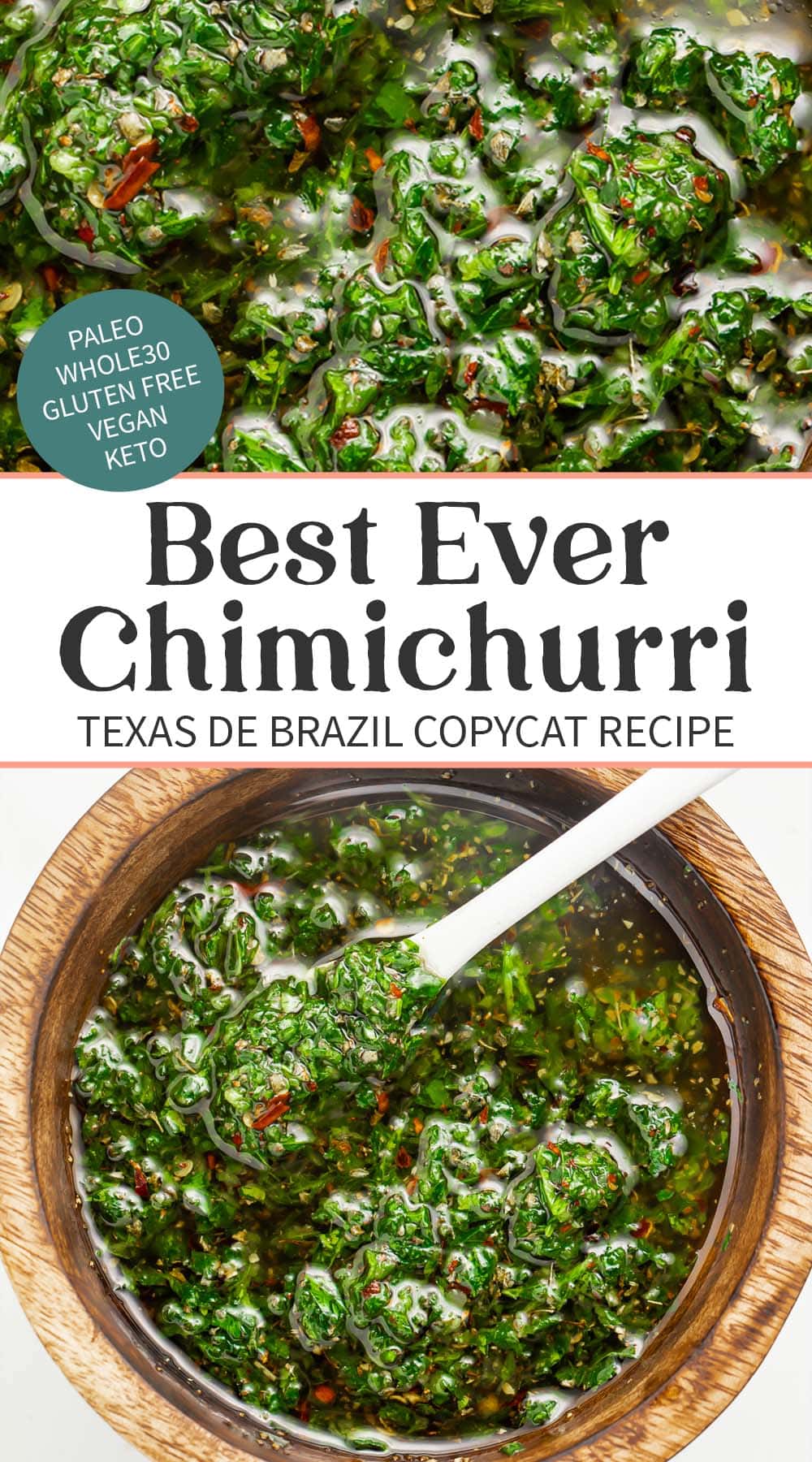
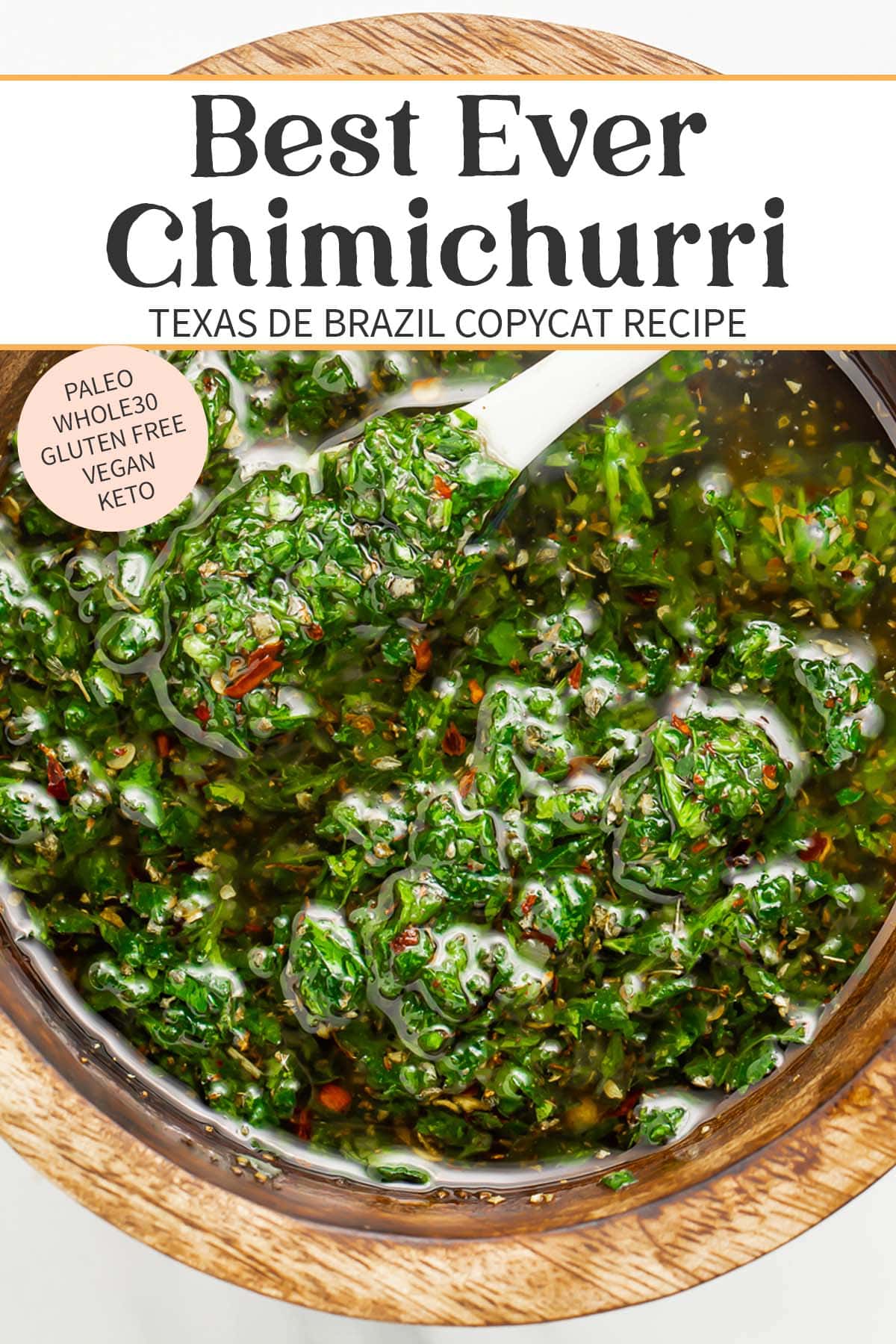
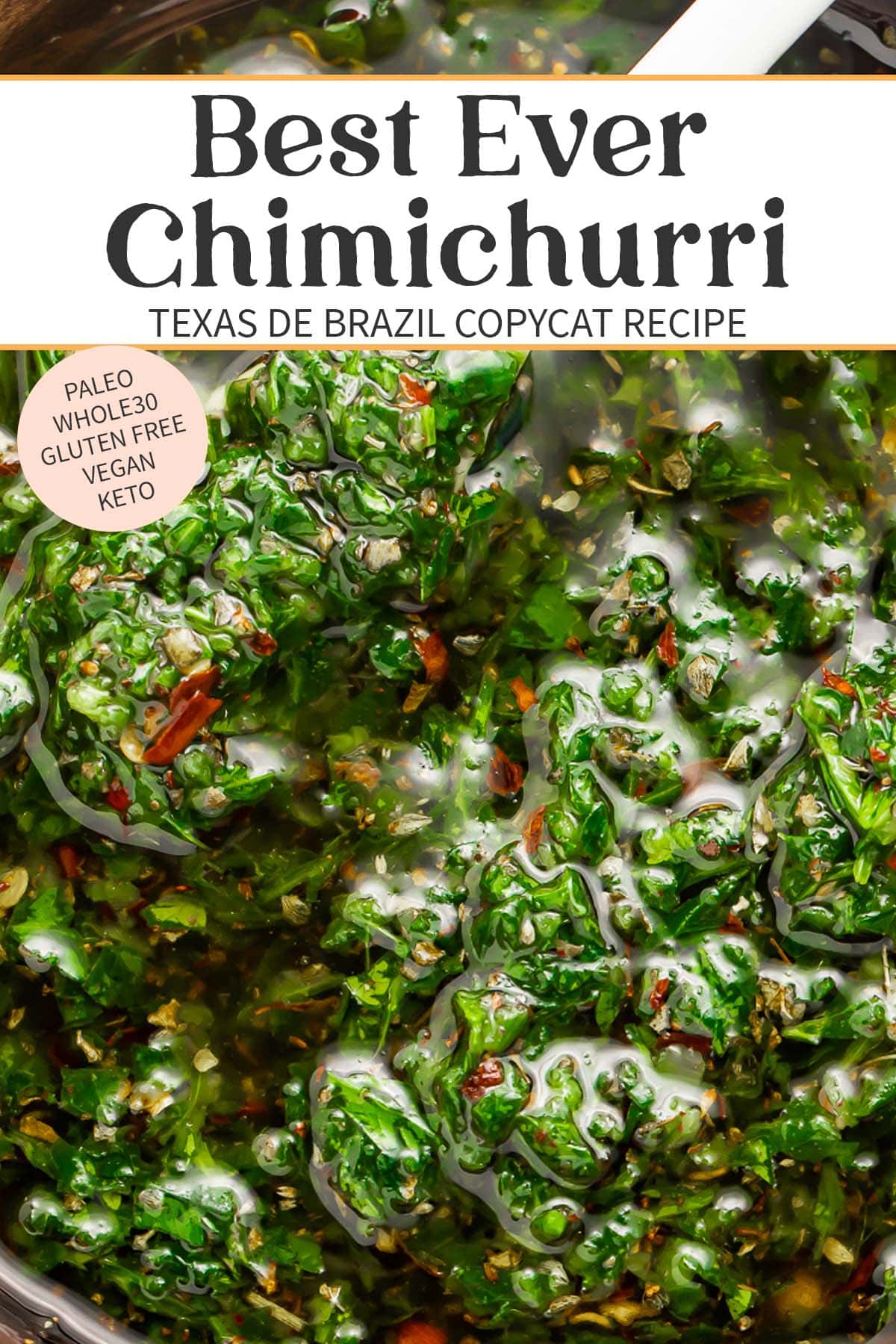
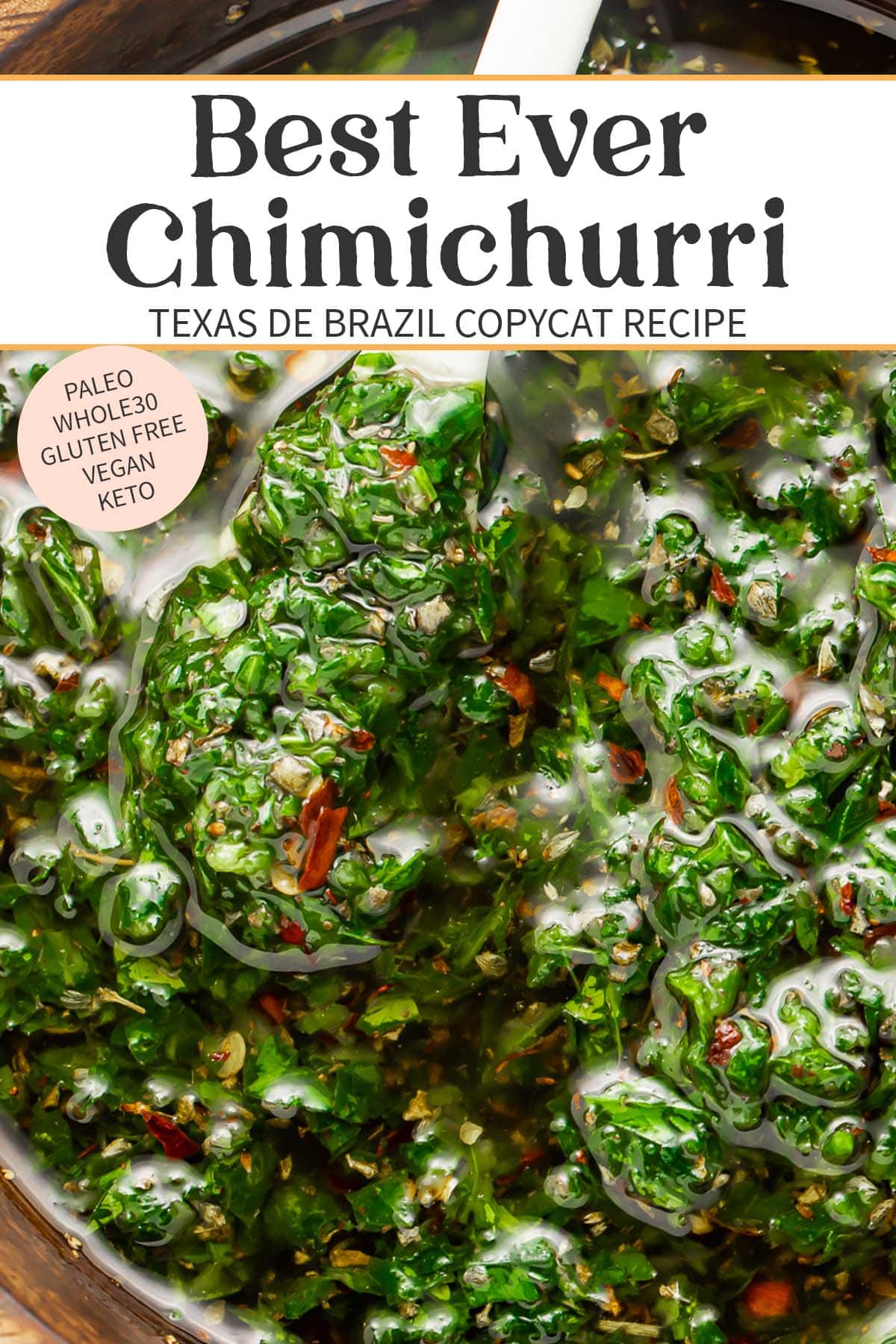

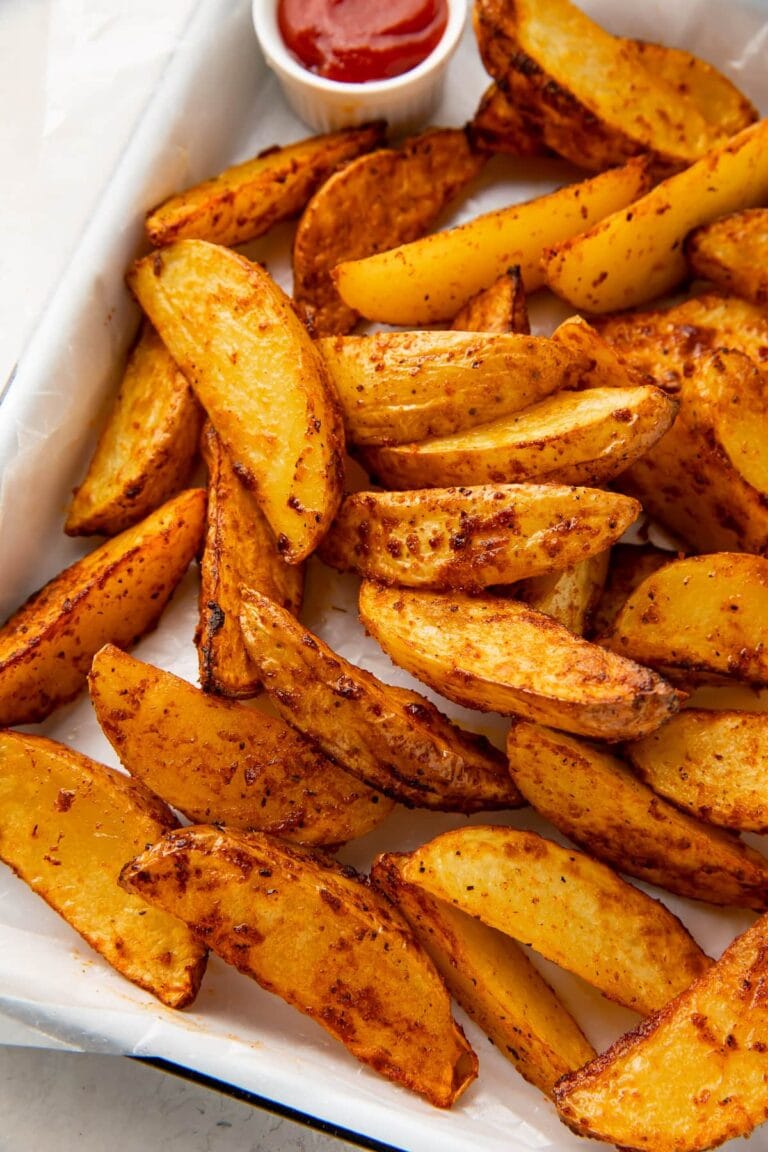
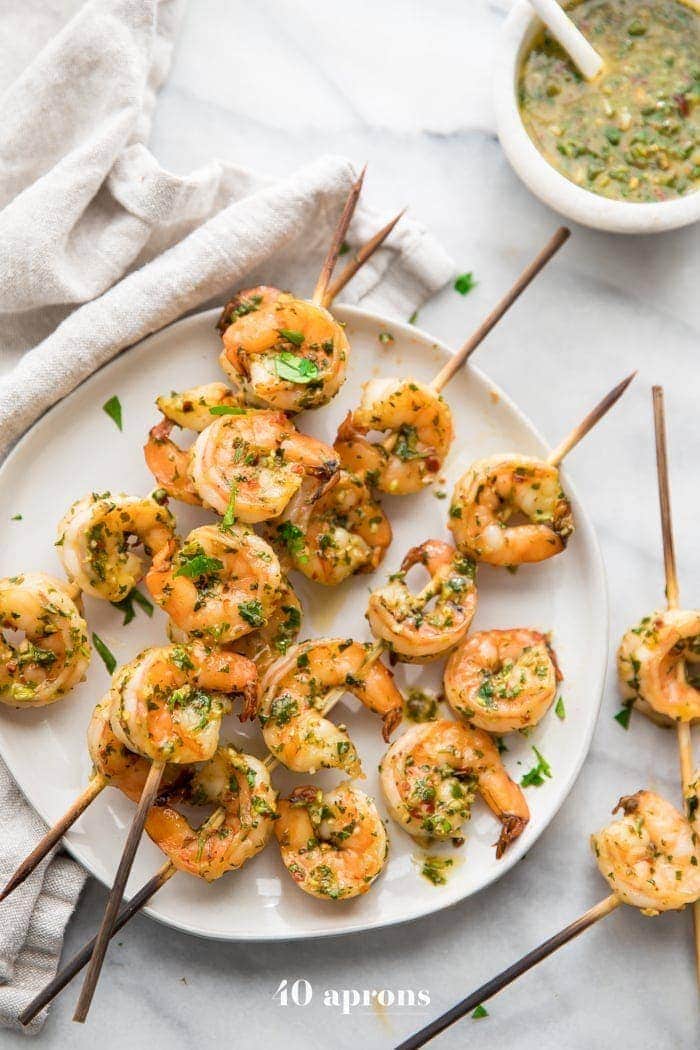
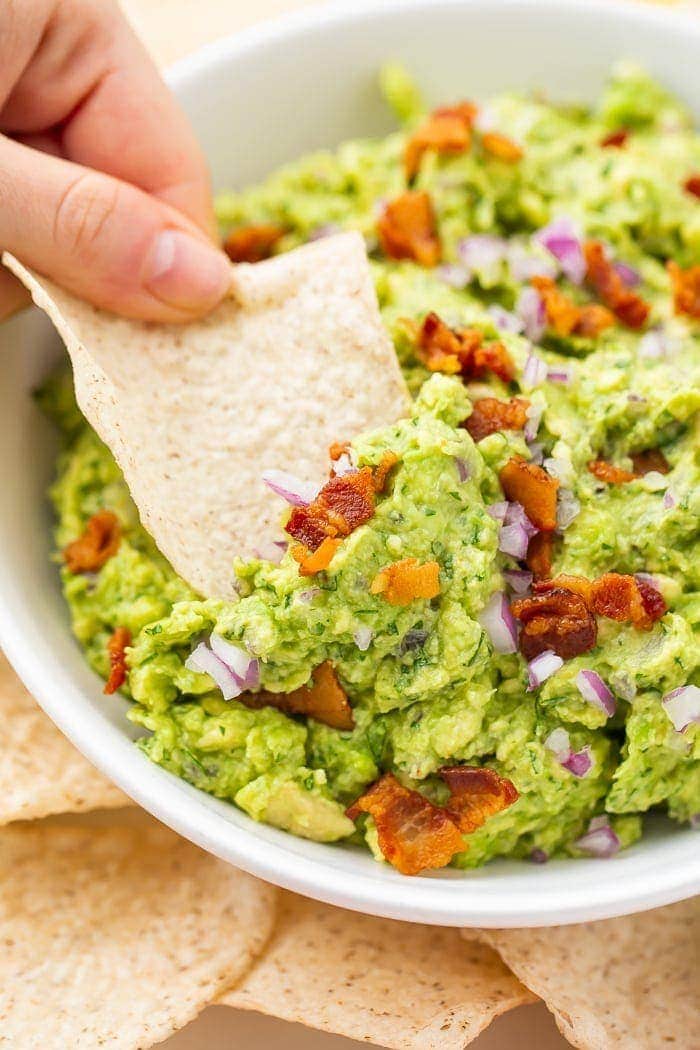











Best chimichurri EVER. It tastes just like TDB. Try it on brown rice. Oh my!
So happy you like it as much as we do!!
This looks awesome! I’ve been looking for a great recipe to try, and I can’t wait to make this! In this picture, did you throw it all in the blender?
In this picture I chopped everything by hand, BUT, I almost always use the food processor now. We make so much and we have a baby.. haha! It’s great either way
Glad Eli liked it too 😀
I just made this and now I can’t wait to eat dinner tonight!!! It tastes so good 🙂
Hi there,
I never write comments but we had this on grilled pork and lamb and it was amazing! I stuck it in the mini blender and let it sit overnight for the flavors to marry. I can’t say enough about how delicious it was and inspired a whole lot of cooking in my kitchen. It’s great on anything, especially grilled corn!
ok, this is legit. . I had to check it out. . I love chimichurri and hell no to mediocre olive oil here.
Oh, oh Alice, oh. It’s SO good. You really should try it.. oh man. I made a double batch last night and am salivating just thinking of it!
Greetings from Guatemala!!
I love your recipe, I am totally in love with it, thanks!! Just wanted to know if it is possible to make two or three jars at once (or 3x the recipe amounts), and save it using a canning method (air tight). Does the heat of this method alter the flavor or product life once opened??
Anybody there willing to help me???? Thanks all!!
Oh man.. I don’t have much working knowledge of canning methods at all so I can’t really give you any solid info there. I would assume that heat would affect the flavor somewhat but it’s probably not by much! Even when I roast or bake something with the chimichurri, the flavor is still basically the same. Give it a whirl.. and let me know! Thanks Maya! 🙂
I’m not entirely sure about canning with fresh herbs like this, but something I do think would work is freezing. I’ve actually frozen pesto and simliar sauces with great success. One of the best ways I’ve found: using ice cube trays! Once they’re frozen solid, pop them out and put them in a freezer bag. That way you can use a little at a time or a lot. They will defrost in the fridge or put a couple cubes in a separate ziplock and massage in warm water until they break up. 🙂
Yes! Freezing! Great idea
HI I think you can freeze the chimichurri because I make cilantro chimichurri and that freezes well. When you need it just take it out the night before and leave it in the fridge to thaw or leave it on counter for an hour… hope this helps
Hi – I no longer see the chimichurri recipe on your site. Did you remove it?
So sorry about that! THe recipe plugin we used to use totally tanked and we’ve been slowly updating all the recipes. It’s fixed now.. try again 🙂 Thanks for your patience! This chimichurri is *totally* worth it!
Thank you, Cheryl, for sharing this recipe. I’m glad you enjoy chimichurri so much, and have found many uses for it. I grew up in Argentina, and chimichurri is definitely a trademark from the land of the best beef in the world… OK, arguably, these days. =) In Argentina, cilantro is not used much at all, in fact, I came to know about it when I came to the USA. I’m glad I developed a taste for it, as I think it makes chimichurri better than by just using parsley. Also, and this may make you love this sauce even better, try adding pine nuts (finely chopped) in it! Pine nuts are expensive, but here in the states are more accessible than in South America. If you thought this couldn’t get any better, you might be up to a big surprise. For the 4th of July, I made a brisket with chimichurry (that’s how you make everything Argentinean style), and people loved it. I was hoping for left overs… not such luck! 😉 Thanks for sharing your knowledge and talent!
Wow, Gustavo, so much amazing information! I know I had always been interested in chimichurri growing up–its vibrant shade and promise of so many herbs bursting with bright flavor–but when I saw it was only parsley, I was a bit “meh” about the whole concept. I hate to admit that I fell head over heels in love with chimichurri when I had it at Texas de Brazil, I think because of the cilantro and oregano! It’s so interesting to hear you say that even you think it’s better with cilantro, though it’s not traditional! The pine nuts addition sounds amazing–like you could even come up with a chimichurri-style pesto.. mmmmm! I KNOW I have to try that. And your 4th celebration sounds amazing! Just wish I had been invited.. geez.. Haha!
Hi, in the UK here and wanted clarification on “1 tablespoon of red crushed pepper” is this dried Chile pepper plakes, or fresh red chilies crushed, if you could help, thanks
So sorry about that! That’s dried red pepper flakes. But I bet fresh chiles would be great too, just not sure on the amount.
Would you put the pine nuts in the food processor or whole? Thanks
Donna white.
Finely chop the pine nuts.
This is so yummy. I used 2 T chopped fresh oregano instead of dried, and 1 teaspoon of salt was plenty for me. Great on all kinds of stuff. Thanks for the recipe!
Yum! Fresh oregano sounds great. Glad you liked it! Now I’m having a major craving..